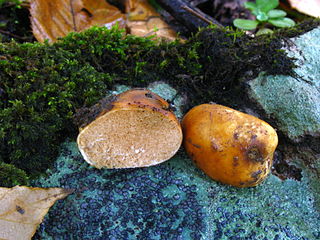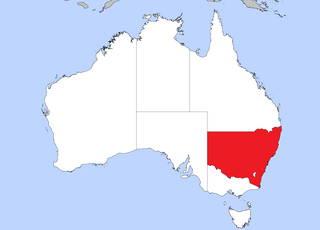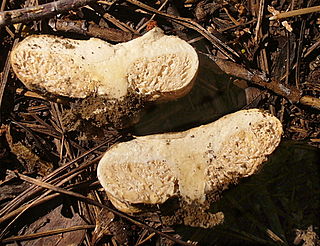
The Russulaceae are a diverse family of fungi in the order Russulales, with roughly 1,900 known species and a worldwide distribution. They comprise the brittlegills and the milk-caps, well-known mushroom-forming fungi that include some edible species. These gilled mushrooms are characterised by the brittle flesh of their fruitbodies.

Russula is a very large genus composed of around 750 worldwide species of ectomycorrhizal mushrooms. They are typically common, fairly large, and brightly colored – making them one of the most recognizable genera among mycologists and mushroom collectors. Their distinguishing characteristics include usually brightly coloured caps, a white to dark yellow spore print, brittle, attached gills, an absence of latex, and absence of partial veil or volva tissue on the stem. Microscopically, the genus is characterised by the amyloid ornamented spores and flesh (trama) composed of spherocysts. Members of the related genus Lactarius have similar characteristics but emit a milky latex when their gills are broken. The genus was described by Christian Hendrik Persoon in 1796.

Cystangium is a genus of fungi in the family Russulaceae. The genus contains 32 species that are distributed in Australia and South America. Cystangium was described by American mycologists Rolf Singer and Alexander H. Smith in 1960.

Multifurca is a rare genus of ectomycorrhizal fungi in the family Russulaceae. It was described in 2008, after molecular phylogenetic study had shown that it forms a monophyletic lineage within the family, sister to Lactarius. The genus contains six species known from the United States, Mexico, Costa Rica, India, China, Thailand, Australia, and New Caledonia, but so far has not been reported from Europe, Africa, or South America. Four of those species were formerly classified as Russula section Ochricompactae, and Multifurca furcata was originally described as a Lactarius species.

Zelleromyces is a genus of fungi in the family Russulaceae. It was first described by mycologists Rolf Singer and Alexander H. Smith in 1960 to contain hypogeous (underground) fungi with gasteroid fruit bodies that "bleed" latex when they are cut.

Thaxterogaster argyrionus is a species of sequestrate (truffle-like) fungus in the family Cortinariaceae. Described as a new species in 2010, it is known only from New South Wales.

Thaxterogaster nebulobrunneus is a species of truffle-like fungus in the family Cortinariaceae. Found in New South Wales, Australia, the species was described as new to science in 2010.
James Martin Trappe is a mycologist and expert in the field of North American truffle species. He has authored or co-authored 450 scientific papers and written three books on the subject. MycoBank lists him as either author or co-author of 401 individual species, and over the course of his career he has helped guide research on mycorrhizal fungi, and reshaped truffle taxonomy: establishing a new order, two new families, and 40 individual genera.

Arcangeliella is a genus of gasteroid fungi in the family Russulaceae. Taxonomic and phylogenetic research has shown that it is very likely a synonym of Lactarius. The type species Arcangeliella borziana was moved to Lactarius in 2003. However, the genus name is still in use for several species for which new combinations have not yet been proposed.
Dr Teresa Lebel is a taxonomist and ecologist who works on fungi, with a particular interest in subterranean truffle-like fungi and their mushroom, bolete, bracket or cup relatives.
Russula galbana is a fungus in the family, Russulaceae, found in leaf litter in open forests of Allocasuarina littoralis and Eucalyptus tereticornis in Queensland.
Russula albidoflava is a fungus in the family, Russulaceae, found "in stands of Eucalyptus globulus" in Tasmania.
Russula albobrunnea is a fungus in the family, Russulaceae, found Nothofagus forests of Queensland.
Russula brunneonigra is a fungus in the family Russulaceae, found Eucalyptus forests in New South Wales.
Russula pumicoidea is a fungus in the family, Russulaceae, found on sandy soils in Eucalyptus forests in Western Australia.
Russula reddellii is a fungus in the family, Russulaceae, found in leaf litter in "open,dry forests of Acacia, Allocasuarina, Eucalyptus, Lophostemon and Syncarpia" in Queensland.
Russula sinuata is a fungus in the family, Russulaceae, found in eucalyptus forests in Tasmania.
Russula variispora is a fungus in the family, Russulaceae, found in eucalypt forests in New South Wales.
Lactifluus jetiae is a species of mushroom-forming fungus in the family Russulaceae. It was described by Luke Vaughan, Lachlan Tegart, James K. Douch, and Teresa Lebel in 2021. The specific epithet is a Latinisation of the initials JET, in honour of Jennifer E. Tonkin, who had collected and preliminarily analysed many Australian members of the Russulaceae. The type locality is near the Cann River, Australia.






